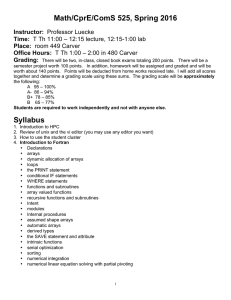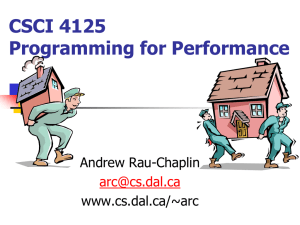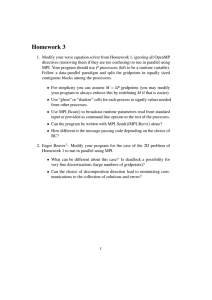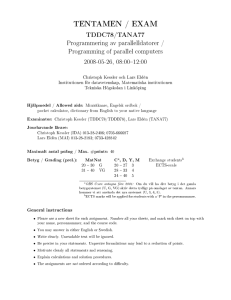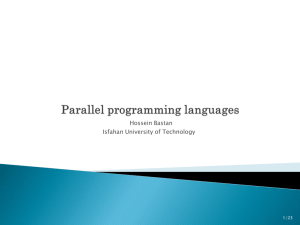Programming Distributed Memory Sytems Using OpenMP
advertisement
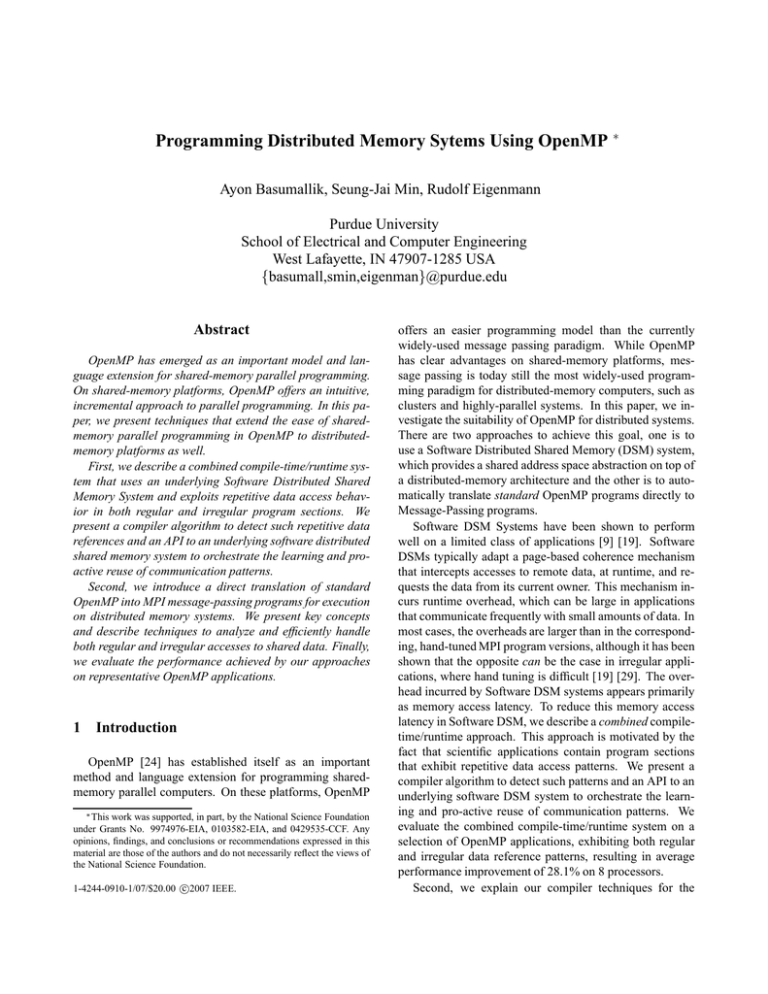
Programming Distributed Memory Sytems Using OpenMP ∗
Ayon Basumallik, Seung-Jai Min, Rudolf Eigenmann
Purdue University
School of Electrical and Computer Engineering
West Lafayette, IN 47907-1285 USA
{basumall,smin,eigenman}@purdue.edu
Abstract
OpenMP has emerged as an important model and language extension for shared-memory parallel programming.
On shared-memory platforms, OpenMP offers an intuitive,
incremental approach to parallel programming. In this paper, we present techniques that extend the ease of sharedmemory parallel programming in OpenMP to distributedmemory platforms as well.
First, we describe a combined compile-time/runtime system that uses an underlying Software Distributed Shared
Memory System and exploits repetitive data access behavior in both regular and irregular program sections. We
present a compiler algorithm to detect such repetitive data
references and an API to an underlying software distributed
shared memory system to orchestrate the learning and proactive reuse of communication patterns.
Second, we introduce a direct translation of standard
OpenMP into MPI message-passing programs for execution
on distributed memory systems. We present key concepts
and describe techniques to analyze and efficiently handle
both regular and irregular accesses to shared data. Finally,
we evaluate the performance achieved by our approaches
on representative OpenMP applications.
1
Introduction
OpenMP [24] has established itself as an important
method and language extension for programming sharedmemory parallel computers. On these platforms, OpenMP
∗ This work was supported, in part, by the National Science Foundation
under Grants No. 9974976-EIA, 0103582-EIA, and 0429535-CCF. Any
opinions, findings, and conclusions or recommendations expressed in this
material are those of the authors and do not necessarily reflect the views of
the National Science Foundation.
c
1-4244-0910-1/07/$20.00 2007
IEEE.
offers an easier programming model than the currently
widely-used message passing paradigm. While OpenMP
has clear advantages on shared-memory platforms, message passing is today still the most widely-used programming paradigm for distributed-memory computers, such as
clusters and highly-parallel systems. In this paper, we investigate the suitability of OpenMP for distributed systems.
There are two approaches to achieve this goal, one is to
use a Software Distributed Shared Memory (DSM) system,
which provides a shared address space abstraction on top of
a distributed-memory architecture and the other is to automatically translate standard OpenMP programs directly to
Message-Passing programs.
Software DSM Systems have been shown to perform
well on a limited class of applications [9] [19]. Software
DSMs typically adapt a page-based coherence mechanism
that intercepts accesses to remote data, at runtime, and requests the data from its current owner. This mechanism incurs runtime overhead, which can be large in applications
that communicate frequently with small amounts of data. In
most cases, the overheads are larger than in the corresponding, hand-tuned MPI program versions, although it has been
shown that the opposite can be the case in irregular applications, where hand tuning is difficult [19] [29]. The overhead incurred by Software DSM systems appears primarily
as memory access latency. To reduce this memory access
latency in Software DSM, we describe a combined compiletime/runtime approach. This approach is motivated by the
fact that scientific applications contain program sections
that exhibit repetitive data access patterns. We present a
compiler algorithm to detect such patterns and an API to an
underlying software DSM system to orchestrate the learning and pro-active reuse of communication patterns. We
evaluate the combined compile-time/runtime system on a
selection of OpenMP applications, exhibiting both regular
and irregular data reference patterns, resulting in average
performance improvement of 28.1% on 8 processors.
Second, we explain our compiler techniques for the
the basic block and tests for loop invariance in L of these
conditions. The gist of checking the second condition is
in testing sequence invariance of all array subscripts. Sequence invariance of an expression means that the expression assumes the same sequence of values in each iteration
of L. (Invariance is a simple case of sequence invariance
– the sequence consists of one value.) The output of the
compiler algorithm is the set of shared variables that incur
repetitive data references across the iterations of L. The detailed algorithm description and examples are illustrated in
our previous work [22].
translation of OpenMP programs directly to Messgae Passing programs (in MPI). To achieve good performance, our
translation scheme includes efficient management of shared
data as well as advanced handling of irregular accesses. In
our scheme, shared data is allocated on all nodes. However,
there are no shadow copies or management structures, as
needed for software DSMs. Furthermore we envision that
for future work, arrays with fully regular accesses will be
distributed between nodes by the compiler. Therefore, we
refer to our scheme as partial-replication. We have studied a
number of OpenMP programs and identified baseline techniques for such a translation as well as optimizations that
can improve performance significantly. We present compiler techniques for translating OpenMP programs to MPI
under the partial replication model and describe a runtime
inspection-based scheme for translating irregular OpenMP
applications.
The remainder of this paper is organized as follows.
Section 2 presents the combined compile-time/runtime system to enhance the performance of OpenMP applications
deployed on distributed-memory systems using Software
DSM. Section 3 describes the automatic translation of
OpenMP programs to MPI programs. Section 4 compares
our approaches with related work. Section 5 concludes the
paper.
2
2.2
The compiler instruments the code to communicate its
findings to the runtime system. It does this through
an API containing two functions, which tell the runtime
system when/where to learn communication patterns and
when/where to repeat them, respectively. The overall model
of program execution is important at this point. We assume
that the program contains an outer, serial loop (e.g., a timestepping loop), within which there are a sequence of parallel
loops, each terminated by a barrier synchronization. This
execution model is consistent with that of many OpenMP
programs. We refer to this outer loop as the target loop.
The compiler identifies the target loop as the outer-most
loop containing parallel sections and a non-empty RepVar,
the set of shared variables with repetitive reference patterns,
described in Section 2.1. Next, it partitions the target loop
body into intervals – program sections delimited by barrier
synchronizations. The API includes the following functions, which the compiler inserts at the beginning of each
interval.
– Get CommSched(CommSched-id, StaticVarList)
– Run CommSched(CommSched-id)
There are two input parameters – CommSched-id is the
communication schedule identifier; StaticVarList is the list
of shared variables with repetitive reference patterns, which
will benefit from pro-active data movement at the beginning
of the interval. Our compiler generates StaticVarList by intersecting the set of shared variables accessed within the
interval and RepVar. Depending on the value of the index
variable of the target loop, either one of these API functions is executed in each iteration. When Get CommSched
is invoked, the runtime system learns the communication
pattern of the variables listed in StaticVarList and creates a
communication schedule, which is the set of data (pages in
case of page-based Software DSM) that experienced remote
memory access misses. On a call to Run CommSched,
the runtime system finds the communication schedule using
CommSched-id and pro-actively moves the data according
to that schedule.
Optimizing OpenMP Programs on Software Distributed Shared Memory System
We describe a combined compile-time/runtime approach
to latency reduction in OpenMP applications, deployed on
Software DSM systems. In previous work [21], we have
presented basic compiler techniques for deploying OpenMP
applications on Software DSM systems. Here, we present
additional optimizations, based on the detection of repetitive access patterns for shared data. Both the compiler and
the runtime system share the task of data reference analysis. The compiler identifies which shared memory accesses
will exhibit repetitive access patterns and when. The runtime system captures information, such as the address and
the destination of remote memory accesses and optimizes
their communication.
2.1
Compiler/Runtime System Interface
Compiler Analysis of Repetitive Data
References
Data references must meet two criteria to be classified
as repetitive accesses in a given loop L. (1) The reference
must be made in a basic block that executes repeatedly in
a sequence of iterations of L and (2) the involved variable
must either be scalar or an array whose subscript expressions are sequence invariant in L. To check the first criterion, the algorithm determines the path conditions [11] for
2
2.3
The Runtime System
Among these programs, WUPWISE, SWIM, and APPLU
are regular applications and CG and SpMul are mixed regular/irregular applications.
Our PCOMP compiler [23] translates the OpenMP applications into TreadMarks programs. After this transformation, we performed repetitive data reference analysis according to the proposed compiler algorithm and instrumented the programs with the described API functions
for pro-active data movement. Overall, our applications
show regular communication patterns in most of their execution, even in irregular program sections. For example, CG
and SpMul have indirect array accesses. In both applications, the indirection arrays are defined outside each target
loops and the compiler analysis is able to determine that the
involved array accesses exhibit static communication patterns. Owing to the precise compiler analysis, we can selectively apply pro-active data movement to only shared variables that show regular communication patterns. Figure 1
presents the performance of the baseline TreadMarks and
that of the proposed compile-time/runtimes system compared to the sequential execution times. Programs are executed on 1, 2, 4, and 8 processors. On 8 processors, the proposed technique achieves 28.1% performance improvement
over the baseline TreadMarks system. The performance enhancement mainly comes from the reduction of the number
of messages and the reduction of the page fault overhead.
Our compiler analysis makes it possible to obtain these reductions by applying pro-active data movement to the right
data at the right time.
We have modified the TreadMarks [2] version 1.0.3.3 to
support the pro-active data movement with message aggregation. The augmented runtime system captures the communication pattern and creates the communication schedule
during the interval where Get CommSched is called. On a
call to Run CommSched, the augmented runtime system applies the communication schedule by pro-actively moving
data. When there are multiple messages to the same processor, those messages are aggregated into a single message to
reduce the number of messages communicated. Also, the
shared data that are pro-actively moved will not incur remote memory misses during the execution, which results in
the reduction of DSM coherence overheads.
2.4
Performance Evaluation
6
5
4
3
3 Translation of OpenMP to MPI
2
In the previous section, we discussed a combined
compile-time/run-time optimization scheme for OpenMP
applications deployed through Software DSM systems.
However, Software DSM systems suffer from some inherent performance limitations. A comparative study of
Message-Passing(using PVM [26]) and TreadMarks applications [20] concluded that message-passing applications
have two basic advantages over Software DSM applications. The first advantage is that message-passing applications can piggyback synchronization with sends and receives of data whereas Software DSMs incur separate overheads for synchronization and data transfer. The second
advantage is that message-passing applications implicitly
perform aggregation for transferring data while Software
DSMs are limited by the granularity at which they maintain
coherence for shared data(for example, page-based software
DSMs perform shared data transfers on a per page basis).
Techniques using prefetch [27] and compiler-assisted analysis of future accesses for aggregation [10] have been proposed to mitigate these performance limitations.
In order to avoid the performance limitations imposed
1
0
1 2 4 8
wupwise
1 2 4 8
swim
Baseline
1 2 4 8
applu
1 2 4 8
SpMul
1 2 4 8
CG
Compile/Run-Time Opt
Figure 1. Speedup for TreadMarks and the
Combined Compile-time/Run-time System
We evaluated the combined compile-time/runtime system on a selection of SPEC OMP and NAS OpenMP benchmarks, exhibiting both regular and irregular communication patterns. Our commodity cluster consists of PentiumII/Linux nodes, connected via standard 100Mbps Ethernet
networks. We used five Fortran programs: WUPWISE,
SWIM, and APPLU from the SPEC OMP benchmarks
and CG from the NAS OpenMP benchmarks and SpMul.
3
by a Software DSM system, we explore the possibility of
translating OpenMP applications directly to message passing applications that use MPI. Essentially, an SDSM layer
performs two functions:
and omp single directives. Iterations of OpenMP parallel for loops are statically partitioned between processes using block-scheduling.
• Shared data, is allocated on all processes. There is no
concept of an owner for any shared data item. There
are only producers and consumers of shared data.
• It traps accesses to remote data.
• It provides a mechanism for intercommunicating data
between nodes on demand.
• At the end of parallel constructs, each participating
process communicates the shared data it has produced
that other processes may use in the future.
For the first function, we now use a combination of
compile-time analysis and runtime methods to resolve remote accesses. For the second function, we use MPI libraries to communicate data. The direct use of message
passing provides the compiler greater control of when and
how processes intercommunicate their data and thus makes
it easier to optimize this communication as well as to implement aggregation and prefetching. Additionally, robust and
optimized MPI libraries are available for almost all types of
distributed-memory platforms.
To achieve good performance, our translation scheme includes efficient management of shared data as well as advanced handling of irregular accesses. In this section, we
present a brief overview of the baseline compile-time translation scheme for translating OpenMP applications to MPI
and then we present a runtime inspection-based scheme for
translating OpenMP applications that have irregular data accesses.
3.1
An exception to redundant execution of the serial regions
is file I/O. Reading from files is redundantly done by all
processes (we assume a file-system visible to all processes).
Writing to file is done by only one process (the process with
the smallest MPI rank).
After interpreting the OpenMP directives, the compiler
needs to inserts MPI calls to communicate shared data
from producers to potential future consumers. To resolve
producer-consumer relationships, the compiler has to perform precise array-dataflow analysis. Several schemes such
as Linearized Memory Access Descriptors [25] and Regular
Section Descriptors [6] have been proposed to characterize
array accesses. Our compiler constructs bounded regular
section descriptors [12] to characterize accesses to shared
arrays.
The compiler constructs a control flow graph (with each
vertex corresponding to a program statement) and records
array access summaries with Regular Section Descriptors
(RSDs) by annotating the vertices of the control flow graph.
The compiler then uses this annotated control flow graph to
create a producer-consumer flow graph which is used to resolve producer-consumer relationships for shared data. This
graph is created by modifying the annotated control-flow
graph to conform to the relaxed memory consistency model
of OpenMP. OpenMP specifies implicit and explicit memory synchronization points.
The compiler now uses this producer-consumer flow
graph to compute message sets for communicating shared
data from producers to potential consumers. In previous
work [3], we have discussed the algorithm for computing
these message sets. The computed message sets are communicated using non-blocking send/receive and blocking
wait calls.
For affine accesses, the compiler can create precise regular section descriptors and thus generate precise message
sets for communicating data between producers and consumers. However, in cases where array accesses are not
regular, the compiler cannot perform the shared array access analysis precisely at compile-time. We now present
run-time mechanisms for translating applications with such
irregular accesses.
Baseline OpenMP to MPI Translation
Scheme
The objective of the baseline translation scheme is to
perform a source-to-source translation of a shared-memory
OpenMP program to an MPI program. This is accomplished
by two categories of transformations – (1) transformations
that interpret the OpenMP directives and (2) transformations that identify and satisfy producer-consumer relationships for shared data.
OpenMP directives fall into three categories (1) directives that specify work-sharing (omp parallel for,
omp parallel sections) - the compiler interprets these to partition work between processes,
(2) directives that specify data properties (omp shared, omp
private etc.) - these are used for constructing the set of
shared variables in the program. By default, data is shared
as per the OpenMP standard.
(3) synchronization directives (omp barrier, omp critical,
omp flush etc.) - the compiler incorporates these into the
control flow graph.
The target execution model for our translation scheme is
SPMD [7] with the following characteristics:
• All participating processes redundantly execute serial
regions and parallel regions demarcated by omp master
4
L1 : #pragma omp parallel for
for(i=0;i<N;i++)
p[i] = x[i] + alpha*r[i] ;
L1 : #pragma omp parallel for
for(i=0;i<N;i++)
p[i] = x[i] + alpha*r[i] ;
L2 : #pragma omp parallel for
for(j=0;j<N;j++) {
w[j] = 0 ;
for(k=rowstr[j];k<rowstr[j+1];k++)
S2:
w[j] = w[j] + a[k]*p[col[k]] ;
}
L2-1 : #pragma omp parallel for
for(j=0;j<N;j++) {
w[j] = 0 ;
}
L2-2:
Figure 2. Sparse Matrix-Vector Multiplication
Kernel
3.2
S2:
#pragma omp parallel for
for(j=0;j<N;j++) {
for(k=rowstr[j];k<rowstr[j+1];k++)
w[j] = w[j] + a[k]*p[col[k]] ;
}
Figure 3. Sparse Matrix-Vector Multiplication
Kernel with Loop Distribution of loop L2
Translation of Irregular OpenMP Applications to MPI
L3: for(i=0;i<num_iter;i++)
w[T[i].j] = w[T[i].j] +
a[T[i].k]*p[T[i].col] ;
Irregular applications pose a challenge, because the compiler cannot accurately analyze the accesses at compile
time. Instead, it must conservatively over-estimate data consumption. Consider the following code.
Figure 4. Restructuring of Sparse MatrixVector Multiplication Loop
L1 : #pragma omp parallel for
for(i=0;i<10;i++)
A[i] = ...
L2 : #pragma omp parallel for
for(j=0;j<20;j++)
B[j] = A[C[j]] + ...
Previous work on inspectors in the context of languages
such as HPF and Titanium [8, 1, 14] have suggested reordering loop iterations to differentiate local and non-local accesses. Consider a common sparse matrix-vector product
shown in Figure 2, taken from the NAS Conjugate Gradient
benchmark. The irregular access here occurs in statement
S2 inside the nested loop L2. Each outer j iteration in loop
L2 now contains multiple irregular accesses to the vector p,
which is produced blockwise in loop L1. Therefore, simply
reordering the outer j iterations may not suffice to partition
accesses into accesses of local and remote data.
To expose the maximum available opportunity for
computation-communication overlap, the loop L2 in Figure 2 is restructured to the form shown in Figure 3. Loop
L2 is distributed into the loop L2-1 and the perfectly nested
loop L2-2. On each process, at run-time, inspection is done
for statement S2 and in every execution i of statement S2,
the loop indices j and k as well as the corresponding value
of col[k] are recorded in an inspection structure T . T here
can be considered a mapping function T : [j, k, col[k]] →
[i]. This mapping can then be used to transform loop L2-2
in Figure 3 to loop L3 in Figure 4. Iterations of loop L3 can
now be re-ordered to achieve maximum overlap of computation and communication in our sparse matrix-vector multiplication example.
In previous work [4], we have presented the algorithms
Considering parallel execution on 2 processes (numbered 0 and 1), the compiler summarizes the writes in
Loop L1 using an RSD of the form < p, write, A, 1, 5 ∗
p, 5 ∗ p + 5 >. For L2, the compilers produces the
two RSDs < p, write, B, 1, 10 ∗ p, 10 ∗ p + 5 > and
< p, read, A, 1, undef ined, undef ined >. In L2, array
A is accessed using the indirection array C and thus, the
accesses to A cannot be resolved at compile time. In such
cases, our existing compiler [3] attempts to deduce certain
characteristics (e.g., monotonicity) for the indirection array
A. This information serves to obtain bounds on the region
of array A accessed by each process. If no such property
can be deduced, our translation scheme will determine that
at the end of loop L1, process 0 must send elements A[0]
through A[4] to process 1 and process 1 must send elements A[5] through A[9] to process 0, which may result
in excess communication. To precisely resolve such irregular accesses, our system makes use of runtime inspection.
A key insight is that runtime inspection not only resolves
producer consumer relationships precisely for irregular accesses, it also maps accesses to loop iteration. Therefore, to
amortize the cost of runtime inspection, we can use this information to reorder iterations for parallel loops to overlap
computation and communication.
5
Scalability on IBM SP2
25
Speedup
20
15
10
5
0
1 2 4 8 16
CG
1 2 4 8 16
EP
1 2 4 8 16
1 2 4 8 16
FT
1 2 4 8 16
LU
Translated OpenMP
1 2 4 8 16
IS
ART
1 2 4 8 16
EQUAKE
Hand-coded MPI
Figure 5. Scalability comparison on the IBM SP2 nodes. The input data set used is CLASS B for all
the NAS benchmarks and train for the SPECOMPM2001 benchmarks.
to affect these runtime inspection and loop restructuring
transformations.
Performance Evaluation
1400
Execution Time (in seconds)
3.3
transformations, the translated OpenMP versions achieved
speedups to within 9% of the hand-translated MPI versions.
To evaluate the performance of our translation scheme,
we have applied the OpenMP translation steps discussed in
this section to seven representative OpenMP applications
- five from the NAS Parallel Benchmarks and two SPEC
OMPM2001 applications (EQUAKE and ART). Our hardware platform is a set of sixteen IBM SP2 WinterHawk-II
nodes connected by a high-performance switch. We expect
the scaling behavior of the benchmarks on these systems to
be representative of a wide class of high-performance computing platforms. In Figure 5, we compare the scaling behavior of the benchmarks translated to MPI from OpenMP
with the scaling behavior of their hand-translated MPI
counterparts (for NAS benchmarks, the hand-translated versions are the official MPI versions of these benchmarks. For
EQUAKE and ART, we have created the reference MPI verions ourselves with reasonable programming effort). On
average, we observed that the translated OpenMP versions
have performance to within 15% of their hand translated
MPI counterparts. Additionally, the NAS benchmark CG
and the SPEC OMPM2001 benchmark EQUAKE contain
irregular array accesses in their most time consuming parts.
We applied the transformations discussed in Section 3.2 to
these applications. The performance of the resulting translation is shown in Figures 6 and 7. We found that with these
1200
1000
800
600
400
200
0
1
2
4
8
16
Number of Nodes
NPB-2.3-MPI
Inspector without Reordering
Baseline Translation
Inspector with Iteration Reordering
Figure 6. Performance of CG.
4 Related Work
Researchers have proposed numerous optimization techniques to reduce remote memory access latency on Software DSM. Many of these optimization techniques aim to
perform pro-active data movement by analyzing data access
patterns either at compile-time or at runtime. In compiletime methods, a compiler performs reference analysis on
source programs and generates information in the form of
6
nication. Partial replication also obviates the need for data
partitioning techniques [18], even though data distribution
information is not provided by the user.
Execution Time (seconds)
1200
1000
800
5 Conclusions
600
400
In this paper, we have discussed two approaches aimed
at making OpenMP shared-memory programming available
for distributed-memory systems as well. First, we examined
a combined compile-time/runtime approach for accelerating the execution of applications with repetitive communication patterns deployed through Software DSM. Our compiler algorithm is essential to accurately and selectively apply pro-active data movement to remote memory accesses
showing static communication patterns. We evaluated the
proposed compile-time/runtime system using OpenMP applications, consisting of both regular and irregular applications. We achieved performance improvements as significant as 44% and on average 28.1% on 8 processors.
Second, we examined techniques for translating standard
OpenMP shared-memory programs directly to a Message
Passing form. We discussed the basic OpenMP to MPI
translation scheme and the translation of irregular OpenMP
applications into MPI codes. We found that the translated
OpenMP versions have the performance to within 15% of
their hand-translated MPI counterparts.
Our measurements show that the presented techniques,
a combined compile-time/runtime technique on Software
DSM and direct translation of OpenMP to MPI, significantly improve the performance of OpenMP on distributed
memory systems. This fact, combined with the greater ease
of programming that OpenMP is generally attributed with,
indicates a promising new path toward higher programming
productivity on distributed-memory platforms.
200
0
1
2
4
8
16
Nodes
Hand-Coded MPI
Inspection (No Reordering)
Baseline (No Inspection)
Inspection and Reordering
Figure 7. Performance of Equake.
directives or prefetch instructions that invoke pro-active
data movement at runtime [9]. The challenges for compiletime data reference analysis are the lack of runtime information (such as the program input data) or complex access patterns (such as non-affine expressions). By contrast,
runtime-only methods predict remote memory accesses to
prefetch data [5] based on recent memory access behavior.
These methods learn communication pattern in all program
sections and thus incur overheads even in those sections that
a compiler could recognize as not being beneficial. The idea
of combined compile-time/runtime solutions has been expressed by others [28, 16, 15]; however, our paper [22] is
the first to present a compiler algorithm and a corresponding
application program interface (API), allowing the compiler
and runtime system to work in concert.
An important contribution towards a simpler programming model for distributed-memory machines was the development of High Performance Fortran (HPF) [13, 17].
There are important differences between our OpenMP-toMPI translation approach and that taken by HPF. Even
though, like OpenMP, HPF provided directives to specify
parallel loops, HPF’s focus was on the use of the data distribution directives. Data and computation partitioning was
derived from these directives. Most often, data had a single
owner and computation was performed on the owning node
(a.k.a owner-computes rule). Input operands to the computations were received via messages from their owners. This
execution scheme could also add significant overhead to serial sections, as these needed be executed on multiple nodes
owning parts of the data. Handling irregular data was difficult and usually employed runtime schemes [8]. In contrast to HPF implementations, our execution model starts
from the available parallelism specified through OpenMP
directives. Partial replication allows serial regions to be executed intact and input operands of parallel computations
are locally available. Communication happens primarily at
the end of parallel loops, facilitated by collective commu-
References
[1] T. S. Abdelrahman and G. Liu. Overlap of computation and communication on shared-memory networks-ofworkstations. Cluster computing, pages 35–45, 2001.
[2] C. Amza, A. L. Cox, S. Dwarkadas, P. Keleher, H. Lu, R. Rajamony, W. Yu, and W. Zwaenepoel. Treadmarks: Shared
Memory Computing on Networks of Workstations. IEEE
Computer, 29(2):18–28, 1996.
[3] A. Basumallik and R. Eigenmann. Towards automatic translation of openmp to mpi. In ICS ’05: Proceedings of the
19th annual International Conference on Supercomputing,
pages 189–198, Cambridge, Massachusetts, USA, 2005.
ACM Press.
[4] A. Basumallik and R. Eigenmann. Optimizing Irregular
Shared-memory Applications for Distributed-memory Systems. In PPoPP ’06: Proceedings of the eleventh ACM
SIGPLAN symposium on Principles and practice of parallel
programming, pages 119–128, New York, NY, USA, 2006.
ACM Press.
7
[22] S.-J. Min and R. Eigenmann. Combined compile-time and
runtime-driven, pro-active data movement in software dsm
systems. In LCR ’04: Proceedings of the 7th workshop on
Workshop on languages, compilers, and run-time support
for scalable systems, pages 1–6, New York, NY, USA, 2004.
ACM Press.
[23] S. J. Min, S. W. Kim, M. Voss, S. I. Lee, and R. Eigenmann.
Portable compilers for openmp. In International Workshop
on OpenMP Applications and Tools (WOMPAT’01), pages
11–19, July 2001.
[24] OpenMP Forum. Openmp: A proposed industry standard
api for shared memory programming. Technical report, Oct.
1997.
[25] Y. Paek, J. Hoeflinger, and D. Padua. Efficient and precise
array access analysis. ACM Trans. Program. Lang. Syst.,
24(1):65–109, 2002.
[26] V. S. Sunderam. PVM: a framework for parallel distributed computing. Concurrency, Practice and Experience,
2(4):315–340, 1990.
[27] A. K. W. L. Todd C.Mowry, Charles Q. C. Chan. Comparative evaluation of latency tolerance techniques for software
distributed shared memory. In Proceedings of the Fourth International Symposium on High-Performance Computer Architecture (HPCA’98), Feb. 1998.
[28] G. Viswanathan and J. R. Larus. Compiler-directed sharedmemory communication for iterative parallel applications.
In Supercomputing, Nov. 1996.
[29] J. Zhu, J. Hoeflinger, and D. Padua. A synthesis of memory
mechanisms for distributed architectures. In Proceedings of
the 15th international conference on Supercomputing, pages
13–22. ACM Press, 2001.
[5] R. Bianchini, R. Pinto, and C. L. Amorim. Data prefetching
for software dsms. In the 12th international conference on
Supercomputing, pages 385–392, 1998.
[6] D. Callahan and K. Kennedy. Analysis of interprocedural
side effects in a parallel programming environment. J. Parallel Distrib. Comput., 5(5):517–550, 1988.
[7] F. Darema, D. A. George, V. A. Norton, and G. F. Pfister. A single-program-multiple-data computational model
for epex/fortran. Parallel Computing, 7(1):11–24, 1988.
[8] R. Das, M. Uysal, J. Saltz, and Y.-S. S. Hwang. Communication optimizations for irregular scientific computations on
distributed memory architectures. Journal of Parallel and
Distributed Computing, 22(3):462–478, 1994.
[9] S. Dwarkadas, A. L. Cox, and W. Zwaenepoel. An integrated compile-time/run-time software distributed shared
memory system. In Proceedings of the seventh international
conference on Architectural support for programming languages and operating systems, pages 186–197, 1996.
[10] S. Dwarkadas, A. L. Cox, and W. Zwaenepoel. An integrated compile-time/run-time software distributed shared
memory system. In Proc. of the 7th Symp. on Architectural Support for Programming Languages and Operating
Systems (ASPLOSVII), pages 186–197, 1996.
[11] T. Fahringer and B. Scholz. Symbolic evaluation for parallelizing compilers. In International Conference on Supercomputing, pages 261–268, 1997.
[12] P. Havlak and K. Kennedy. An implementation of interprocedural bounded regular section analysis. IEEE Transactions on Parallel and Distributed Systems, 2(3):350–360,
1991.
[13] High Performance Fortran Forum. High Performance Fortran language specification, version 1.0. Technical Report
CRPC-TR92225, Houston, Tex., 1993.
[14] P. N. Hilfinger, D. Bonachea, D. Gay, S. Graham, B. Liblit,
G. Pike, and K. Yelick. Titanium language reference manual. Technical report, Berkeley, CA, USA, 2001.
[15] P. Keleher. Update protocols and iterative scientific applications. In Proc. of the first Merged Symp. IPPS/SPDP
(IPDPS’98), 1998.
[16] P. Keleher and C.-W. Tseng. Enhancing software DSMs for
compiler-parallelized applications. In Proc. of the 11th Int’l
Parallel Processing Symp. (IPPS’97), 1997.
[17] C. Koelbel, D. Loveman, R. Schreiber, G. S. Jr., and
M. Zosel. The High Performance Fortran Handbook. MIT
Press, 1994.
[18] U. Kremer. Automatic data layout for distributed memory
machines. Technical Report TR96-261, 14, 1996.
[19] H. Lu, A. L. Cox, S. Dwarkadas, R. Rajamony, and
W. Zwaenepoel. Compiler and software distributed shared
memory support for irregular applications. In Proc. of the
Sixth ACM SIGPLAN Symp. on Principles and Practice of
Parallel Programming (PPOPP’97), pages 48–56, 1997.
[20] H. Lu, S. Dwarkadas, A. L. Cox, and W. Zwaenepoel.
Quantifying the performance differences between PVM and
TreadMarks. Journal of Parallel and Distributed Computing, 43(2):65–78, 1997.
[21] S.-J. Min, A. Basumallik, and R. Eigenmann. Optimizing
OpenMP programs on Software Distributed Shared Memory
Systems. International Journal of Parallel Programming,
31(3):225–249, June 2003.
8
